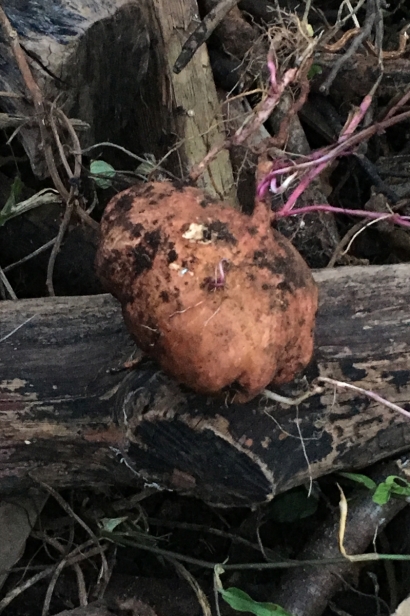The Sweet Potato: 1492
Before the Spanish, the Portuguese, the Dutch, the French and the English arrived at the New World, there grew, among the jagged limestone shores of the southern Bahamas, a most wonderful sweet potato.
Surely there were many wonderful sweet potatoes grown at that time in the Caribbean. Long before, through trade and with the movement of indigenous peoples, this crop had spread from its center of origin in Central and northern South America. But it was this particular sweet potato that would be thrust into the light of discovery one fall day so long ago.
The sweet potato (Ipomoea batata), a member of the morning glory family, is our Caribbean potato, here long before the introduction of the highland Andes potato (Solanum tuberosum). The first Europeans to feast upon its salmon-colored flesh were Christopher Columbus and his crew nearly a century before the Spanish conquest of the Inca and introduction of the potato to Europe. Columbus and his men called the sweet potato “batata” after the Taino word used by the indigenous people. It thrills me to think that the batatas I grow in my Homestead property are direct descendants of those offered to Columbus in his first American cookout.
Our story with the Bahamian batatas began a decade ago with our dear friend, Pericles Maillis, and his family on New Providence, Bahamas. Part lawyer, part mango grower, part fisherman and wholly a philosopher, Pericles has spent a lifetime in conservation and defense of the flora and fauna of the Bahamas. When we stay with him and his family, the rocky ground of his mango orchard is a patchwork of these inspiring sweet potatoes. They came from Cat and Long Island – near-neighbors to San Salvador Island, where Columbus and his men arrived on October 12, 1492. The Lucayan Indians who lived on the island then were gentle and kind, in Columbus’ own words, and no doubt they prepared a pit-oven offering for their visitors, laden with batatas, pumpkins and fish from the surrounding waters. After months and months at sea, for the Spaniards it was the greatest of feasts.
Growing Batatas
For me, the legend, the horticulture and the adaptability of this amazing crop are irresistible. Sweet potatoes are propagated by cuttings, so it took time to build enough material to serve our needs. All sweet potato vines are cold-sensitive, so cold winters are a challenge. The batata fits like a hand in a glove with our sustainability model for mango growing in South Florida. The plants have few pests and require no chemical pesticides. They thrive without the application of nitrogen, so after planting they can be forgotten until it is time to harvest. They are a perfect intercrop for our mango orchard and our home landscape, where chemical nitrogen can be a bigger curse than an asset, and labor is at a premium. Throughout the year, the leaves can be harvested and used as a delicious, leafy green.
The Cat Island batata is a tuberous root that typically has salmon-colored flesh and an orange outer skin, but they can also be more “boniato”-looking, with a reddish skin and white flesh. They are perfectly adapted to growth and production in the absence of what most would consider a minimum of soil. We plant rooted cuttings in and around the orchard in pockets of organic matter, or in our debris piles following pruning or hurricane cleanup. Generally, we plant in early September to take advantage of the late summer and fall moisture and warmth. We scratch away at the leaf litter and decaying branches to find a planting hole. Once planted, the vines sprawl across the ground and open areas of the orchard, knitting their tuberous roots into the holes in the rock and beneath the low mounds of loose debris. The vines spread over the winter and summer and we harvest in August.
Harvest Time
To harvest, you follow back the vines to find the hidden tubers, and I mean hidden! Often, the batata will form its tubers beneath large roots, in deep holes or anywhere that’s difficult to get at. After the initial harvest, we will find wayward tubers sprouting anew, resulting in a harvest spread over a month or more. We allow the tubers to rest, or cure, on the porch for later consumption. Harvested batatas can be held for several weeks in cool, dry conditions, or they can be peeled, blanched and frozen for later use. They have a drier consistency than the typical orange-fleshed sweet potato in the United States. They also have a pleasant, nutty flavor that you cannot find in boniato or in other commercially available sweet potatoes. Anyone who eats boniato, the white-fleshed sweet potato of the Caribbean, knows and can appreciate this dry consistency.
We’ve been growing and harvesting batatas at our home for years, right around the time of my birthday. What is the perfect present for the man who has everything? It starts with a conversation with Pericles Maillis and the tales of the old Bahamas, its peoples and its crops. It is followed by a harvest of the batatas, rejoicing in its adaptability and resilience. Then there is the making of a wood fire, and the building of a pit into which the batatas and pumpkins from the yard are combined with fish caught earlier in the day. All is wrapped up in banana leaves, covered in coals, served steaming hot with a good red wine. It is a modern-day tribute to our native history and horticulture that never disappoints. Happy birthday to me!






